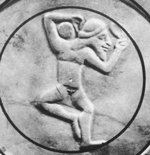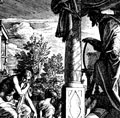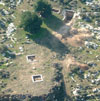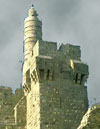The ancient Jewish hero David, "son
of Jesse the Bethlehemite," is a "curiously
elusive figure" (Oxford Companion to the Bible).
In turns shepherd, giant killer, court musician, poet, warlord
and king, nothing and no one outside the Bible notes his existence.
If a historical
'Dawid' inspired tales of a legendary king, the original was an inconsequential
bandit chieftain in the Judaean hills, nothing more.
Possibly the only element of truth in the biblical story is
the episode of David as renegade and outlaw leader, living
from theft.
David and the
Kingdom of Damascus
The city of Damascus is
at least 4000 years old. It is recorded as being conquered by
Pharaoh Tutmosis in the 15th century BC and it became the capital
of an Aramean kingdom from the 11th century BC. The Kingdom
of Aram-Damascus resisted
the Assyrians until late in the 9th century BC, and even came
up against Pharaoh Shoshenk in the Jezreel Valley, conquering
Israelite Dan along the way. Israelite refugees, displaced
by the Arameans, resettled in the hill-country.
In
contrast to its heroics and intrigues of "King David",
the Bible avoids mentioning Aram's 9th century conquest of
much of Israel. Dan,
Hazor, Jezreel and Megiddo were among the cities destroyed.
"Around
835 and 800 BC the kingdom of Aram-Damascus controlled the
upper Jordan valley and significant areas in northeastern Israel – and
devastated major Israelite administrative centres in the fertile
Jezreel valley as well."
– Finkelstein, Silberman,The Bible Unearthed,
p202.
Curiously, King Hazael of Aram-Damascus (844-803) enjoyed a 40-year reign – just like that ascribed to the biblical 'David' (and, for that matter, also to his son 'Solomon'!). The existence of Hazael is not in doubt, whereas outside of the biblical texts, there is as yet NO historical proof of a Hebrew king named David ruling an 'empire'. Much has been made of the so-called Tel Dan Inscription recovered in 1993 (see below) but the "Davidic empire" remains a pious invention, inspired by an Arab kingdom of the same place and time.
Where
Did They Get Their Ideas From?
David – Based
on the King of Damascus
|
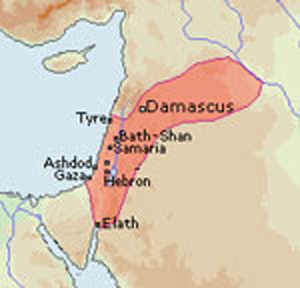
Arab kingdom of Hazael
|
"Damascus
reached its zenith during the reign of Hazael ...
Transjordanian regions were overrun ... Hazael was
able to cross Israelite territory to progress down
the coastal plain to take Gath in Philistia ...
In
fact, Hazael appears to
have established an empire or sphere of influence
not unlike that ascribed to David."
–
B.S.J. Isserlin, The Israelites, p86.
Not David, But Hazael
The city of Methegammah (Tell
es-Safi/ Gath) – hometown of Goliath! – was destroyed in
the 9th century BC, not the 10th, and apparently after a siege.
According to archaeologists
of Bar-Ilan University, the conqueror was none other than Hazael, King of Aram-Damascus !

Philistine pot from Gath |
|
The Fabulous Empire-building of the Biblical King David
"The biblical story of David is indeed mythic in nature.. He spent most
of his career as a brigand-king, and, where he ruled, he did so by employing murder and mayhem.. "
– Baruch Halpern, David's
Secret Demons, p 479/80.
The
fable of King David's "empire building" actually
gets scant coverage in the Holy Book. In the biblical narrative, almost the sole strategy of the Israelite war bands is "surprise." Though inferior in numbers and weaponry, with "surprise attacks" they repeatedly panic vast armies into a disorderly rout.
Episode
1 – Civil War!
Having killed
a giant and married into the royal family with a gift of foreskins,
David falls foul
of his father-in-law Saul and becomes a mercenary
for the hated Philistines. They give him the town
of Ziklag (from where he
massacres Amalekite nomads of Sinai). But when Saul & Co
get trashed by Philistines at Mount Gilboa, Saul's son Ish-Baal (inauspicious
name, that!) is proclaimed king, somewhere east of the river
Jordan.
David, now
resident at Hebron, is also proclaimed king. Hostile co-existence,
laced with a variety of arbitrary
murders,
ensues for over 2 years, at which point the assassination
of Ish-Baal leaves the field free for David to rule "all
Israel" (most of which, of course, is
still in the hands of the Philistines).
Episode
2 – The Capture of Jerusalem!
Our hero decides
he needs a new residence in the hills – the town of Jebus.
Oddly enough, this 'Jebusite' (Canaanite? Philistine?)
enclave, in the heart of 'Hebrew territory', had never succumbed
to
Israelite conquest. Yet David has no problem taking the 'citadel'
(how could he, with the LORD behind his every move). The
blind and lame get short shrift from our conquering hero:
"And
the king and his men went to Jerusalem unto the Jebusites
... which spake unto David, saying ... thou shalt not come
in hither ... Nevertheless
David took the stronghold of Zion ... And David said ... Whosoever getteth
up to the gutter, and smiteth the Jebusites, and the lame and the blind that
are hated of David's soul, he shall be chief and captain.
Wherefore they
said, The blind and the lame shall not come into the house.
So David dwelt
in the fort, and called it the city of David.
– 1
Samuel 5.6,9.
Episode
3 – Conquering everywhere else – just like that!
The brevity
(and brutality) with which the Holy Book records the conquest
of the whole of Syrio/Palestine is breathtaking:
Defeat
of the Philistines:
"And
after this it came to pass that David smote the Philistines,
and subdued them: and David took Methegammah out of the hand
of the Philistines." – 2 Samuel 8.1.
Conquest
of the North:
"David
smote also Hadadezer, the son of Rehob, king of Zobah, as
he went to recover his border at the river Euphrates ... David
slew of the Syrians two and twenty thousand men. David
put garrisons in Syria of Damascus: and the Syrians became
servants to David." – 2 Samuel 8.3,6.
Genocide
and conquest of the South:
"For
it came to pass, when David was in Edom, and Joab the captain
of the host was gone up to bury the slain, after he had smitten
every male in Edom." – 2 Kings 11.15.
Mass
Slaughter in the Transjordan:
"And he
smote Moab, and measured them with a line, casting
them down to the ground; even with two lines measured he
to put to death, and with one full line to keep alive.
And so the Moabites became David's servants, and brought
"–2 Samuel 8.2.
"And it came to pass, after the year was expired, at the time when kings
go forth to battle, that David sent Joab, and his servants with him, and all
Israel; and they destroyed the children of Ammon, and besieged Rabbah." –
2 Samuel 11.1.
Not exactly
Julius Caesar's The Gallic Wars!
As archaeology
unequivocally testifies, in the 10th century BC in the valleys
of Palestine Canaanite
culture continued uninterrupted. Thankfully most of
the biblical carnage that is the motif of "David's
Empire Building" is a fanatic's fantasy.
The Tel
Dan Inscription of an Aramean
King |
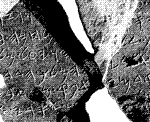
Tel Dan Inscription
"The
author was not
Hazael – it was his son, Bar Hadad ... The
inscription has nothing to do with Jehu's coup and
assassinations."
– George Athas (University
of Sidney – archaeologist
and Christian!)
|
Tel Dan, at the foot of Mount Hermon in northern Galilee, is Israel's longest continuous archaeological dig. Work started in 1966. Three fragments of a 13-line Aramaic inscription discovered by archaeologists of the Nelson Glueck School of Biblical Archaeology in 1993/4 purportedly refer to the "House of David."
One interpretation is that stele records King Hazael's 842 BC killing of "Jehoram, son of Ahab, king of Israel, and Ahaziah, son of Jehoram, king of the House of David. I set their towns to ruin, their land to desolation."
The inscription appears to confirm that a chieftain called David was not pure invention yet even so, it contradicts the biblical story that it was Jehu who assassinated the tribal leaders in Jezreel.
"And
Jehu drew a bow with his full strength, and smote
Jehoram between his arms, and the arrow went out
at his heart, and he sunk down in his chariot ...
But when Ahaziah the king of Judah saw this, he fled
by the way of the garden house. And Jehu followed
after him, and said, Smite him also in the chariot." – 2
Kings 9:24,27
But this interpretation of the fragments has been challenged, both by a realignment of the 3 fragments and a corrected rendering of the word "BYTDWD" – not "House of David" but a place-name meaning "House of Praise".
"The desire
to read the letters bytdvd as house of david is
... a classic example of scholars working backwards
from the Bible rather than forwards from the evidence."
– M.
Sturgis, It
Ain't Necessarily So, p129.
One problem with the early Aramaic of the inscription (which pre-dates the adoption of the square-form developed in Babylon) is the absence of a dot separating words. "DVD" could mean many things, including, for example, uncle, beloved and kettle!
|
|
Reality
Check: The Omride Kingdom of Israel
An
Israelite "empire" did eventually emerge – but
in Samaria not
Judah, and in the 9th, not the 10th century BC. Its founder was
Omri, not David, a soldier/king who built himself the impressive
palace-city of Samaria on the Syrian model. His dynasty – son Ahab,
grandsons Ahaziah and Jehoram – raised a powerful army, built
the cities
of Megiddo, Gezer and Hazor, and ruled a successful state until
defeated by Hazael of Aram-Damascus in
842
BC.
But
the Omrides are not biblical heroes in the mould of David and
Solomon. On the contrary, they are vilified and despised for
that gravest of sins – worshipping the wrong god. In particular, Ahab and his wife Jezebel attract
the worst opprobrium – mouthed
in the curses of the wandering 'prophets' Elijah and Elisha (Jezebel
is thrown from a window and dogs eat her corpse).
The isolated,
poorer, smaller and more backward Israelite chiefdom of Judah,
envious
of and hostile towards its northern neighbour, would eventually
use the fate of Samaria ('Israel') for theological purposes ('Look
what happens when you disobey Yahweh').
Samaria
succumbed to territorial erosion – first to Aram-Damascus,
and
then to
Assyria. The capital city of Samaria finally fell in 720 BC.
Fanatics
of the Yahweh cult fled south and began the process of inventing
Judaism and writing a sacred history. In the fantasy, the village
of Jerusalem
becomes an imperial city; the 'House of David' an imperial dynasty.
First
Evidence of
an Israelite War Lord
In
853 BC, at the hill top city of Qarqur in Syria,
an alliance of petty Levantine kingdoms attempted
to resist the advancing Assyrians. The 'Kurkh
Stela' commemorates the Assyrian victory:
"I
razed, destroyed and burned ... 2,000 chariots,
and 10,000 troops of Ahab, the Israelite ..."
– Shalmaneser
III
The
Assyrians continued their advance in the next campaign
season, defeating 'Jehu,' commemorated on the 'Black
Obelisk'.
|
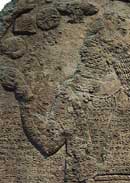
Kurkh
Stela |

|
The 'Black Obelisk'
841
BC |
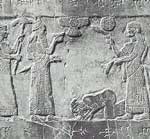
Written
in stone: Israel's 'Jehu, son of Omri' falls to
the ground before Shalmaneser III. |
|
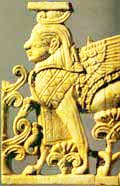
Delicately
carved ivory from Nimrud – testimony to Assyrian
artistry
|
|
Shalmaneser's
artifacts confirm the existence of a small Israelite
kingdom – but NOT of the biblical story:
2
Kings 9,10 has it that Jehu was not Omri's son
but an anointed assassin who had in fact murdered
the 'house of Omri' on orders from Elisha! |
"Woe
to those who lay on beds of ivory."
– Amos
6.4 |
|
Postscript: Biblical David's Deathbed
Words to Solomon: KILL

|
|
Settling the score with Joab, faithful soldier
of the Don:
"Thou
knowest also what Joab the son of Zeruiah did to me ...
Do therefore according to thy wisdom, and let not his hoar
head go down to the grave in peace ...
So Benaiah the son of Jehoiada went up, and
fell upon him, and slew him: and he was buried in his own house
in the wilderness."
– 1 Kings 2.5,34.
Settling the score with Shimei the Benjamite:
"I
sware to him by the LORD, saying, I will not put thee
to death with the sword ...
hold him not guiltless: for thou art a wise man, and knowest what thou oughtest
to do unto him;
but his hoar head bring thou down to the grave with blood.
So
the king commanded Benaiah the son of Jehoiada; which
went out, and fell upon him, that he died. And the
kingdom
was established in the hand of Solomon."
– 1 Kings 2.8,46.
|
| |
Sources:
Paul Johnson, A History of the Jews (Phoenix Grant,
1987)
Dan Cohn-Sherbok, The Crucified Jew (Harper Collins,1992)
Henry Hart Milman, The History of the Jews (Everyman, 1939)
Josephus, The Jewish War (Penguin, 1959)
Baruch Halpern, David's Secret Demons (Eerdmans, 2001)
Leslie Houlden (Ed.), Judaism & Christianity (Routledge, 1988)
John Romer, Testament (Viking, 1999)
Philip R. Davies, In Search of 'Ancient Israel' (Sheffield Academic Press,
1995)
Karen Armstrong, Jerusalem, One City, Three Faiths (Knopf, 1996)
Israel Finkelstein, Neil Silberman, The Bible Unearthed (Simon & Schuster,
2001)
Ahmed Osman, Moses Pharaoh of Egypt (Grafton, 1990)
B.S.J. Isserlin, The Israelites (Thames & Hudson,
1998)

|
 |

|

|
Some fifty articles are now available as a book.
For your copy order:

|
|
|
Copyright © 2004
by Kenneth Humphreys.
Copying is freely permitted, provided credit is given to the author
and no material herein is sold for profit.
|

